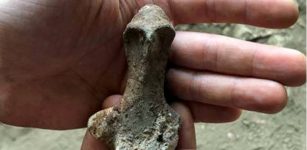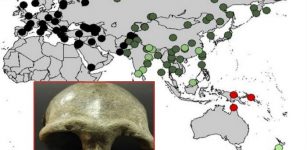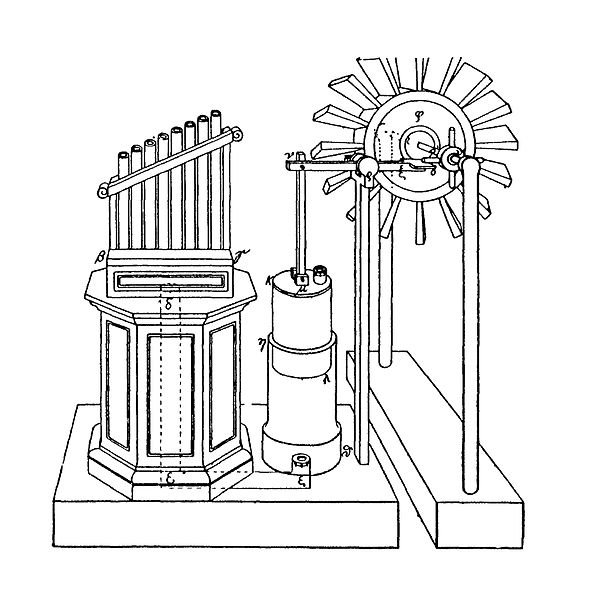Incredible Ancient Machines Invented By Hero Of Alexandria – An Engineer Far Ahead Of His Time
Ellen Lloyd - AncientPages.com - Little is known about Hero of Alexandria except that he was a remarkable ancient engineer far ahead of his time.
He invented several sophisticated machines that demonstrate his vast knowledge of mechanics.
Hero also called Heron, was a Greek mathematician. The date of his birth remains uncertain. Some authorities place his birthday early 150 BCE in Ptolemaic, Egypt. Other scholars date his birth to be 250 CE in the late Roman Empire.
As a student, Hero spent most of his time in the Library at the University of Alexandria. He loved to be in the library with a vast collection of books.
Hero of Alexandria was strongly influenced by the writings of Ctesibius of Alexandria. It is possible he was a student of Ctesibius. When older, he taught mathematics, mechanics, and physical science at the University of Alexandria.
He wrote many books and he used them as texts for his students, and manuals for technicians, and were written in Greek, Latin and Egyptian.
One of his amazing inventions is the so-called "The 'philosopher's stone' of Heron" that "changed" one liquid into another, for example, water into wine.
It consisted of an airtight vase of water which, at the top, had a tubular opening where water entered and reached the bottom and of an airtight vase of wine which, in the middle, had a tap in a siphon shape.
The two vases were connected by an intermediate small tube that entered the bottom and reached close to their top. When a certain amount of water was poured into the first vase, the air inside went through the intermediate tube to the second vase pushing out an equal amount of wine. (The tube arrangement did not allow the mixing of liquids," ('Heron, Pneumatics, A 14').
The hero is credited with the authorship of several manuscripts including Automata, the Pneumatica, the Dioptra, the Catoprica, and the Mechanica.
Hero invented a number of fascinating machines.
Standing on the shoulders of giants, it is believed that Hero studied the works of Archimedes and Vitruvius, as well as Ctesibius.
Most historians agree that some of the inventions included in Hero's manuscripts were, in fact, first created by others.
However, today it is very difficult to determine which invention was his. Therefore, for convenience's sake, most of the machines are simply referred to as "Hero's."
For example, Hero of Alexandria came up with a new invention that depended on the mechanical interaction of heat and water.
He invented a rocket-like device called an aeolipile. It used steam for propulsion. Hero mounted a sphere on top of a water kettle.
A fire below the kettle turned the water into steam, and the gas traveled through the pipes to the sphere. Two L-shaped tubes on opposite sides of the sphere allowed the gas to escape, and in doing so gave a thrust to the sphere that caused it to rotate.
In the book The Pneumatics of Hero Of Alexandria, Bennet Woodcroft, Professor of machinery in University College London lists all of Hero's inventions.
Below is just a selection of some of the machines he invented.
Hero's windwheel used the energy of passing gusts of wind to make an organ play. Unlike his steam engine, this invention did not require any great technical prowess or mechanical plays, but it did apparently require his unique insight.
It should be added that there are not any records of wind-powered machines before Hero came along.
According to the history of vending machines "Hero of Alexandria invented the first coin-operated vending machine dispensing holy water.
Hero's holy water vending machines could be found in temples across the land. These vending machines allowed each member to receive an equal allotment of holy water without requiring the presence of the priest. Hero's vending machines operated on an open valve system. When a coin was placed in the slot of the vending machine, it would rest on a platform. The weight of the coin would push the platform down, opening a valve, and dispensing a consistent trickle of holy water.
Hero's coin-operated holy water vending machines inspired the creation of many other vending machines lending to a financial gain."
This device used both heat and pneumatics to open a set of temple doors. To open the doors, the priest lit a fire on the altar, heating the air within and causing it to expand. This expansion in volume forced water out of the sphere and into the bucket, which moved downwards under the extra weight. This bucket was connected to a rope coiled around a spindle and, as the bucket moved downwards, this spindle revolved, making the doors open.
The first water pumps were probably designed by Ctesibius, as Heron frequently mentions his earlier works in his treatise. The force pump was later widely used in the Roman world for fighting fires.
He was not just a brilliant engineer. He was also an accomplished mathematician and theoretician.
He came up with the basics of what is now known as Fermat's principle. He described a principle of reflection, which stated that a ray of light that goes from point A to point B, suffering any number of reflections on flat mirrors, in the same medium, has a smaller path length than any nearby path.
As a mathematician Hero came up with the first approximation in Greece of a number's square root.
Today, his name is most closely associated with Heron's Formula for finding the area of a triangle from its side lengths. The imaginary number, or imaginary unit, is also noted to have been first observed by Hero while calculating the volume of a pyramidal frustum. He also wrote a number of books on mathematics, including Metrica.
It is almost certain that Hero taught at the Musaeum which included the famous Library of Alexandria because most of his writings appear as lecture notes for courses in mathematics, mechanics, physics, and pneumatics.
Although the field was not formalized until the 20th century, it is thought that the work of Hero, his automated devices, in particular, represents some of the first formal research into cybernetics.
He was very much an engineer and scientist far ahead of his time.
Written by - Ellen Lloyd – AncientPages.com
Copyright © AncientPages.com All rights reserved. This material may not be published, broadcast, rewritten or redistributed in whole or part without the express written permission of AncientPages.com
More From Ancient Pages
-
 El Argar Civilization: Bronze Age Palace And Grave Goods Unearthed In Spain’s La Almoloya
Archaeology | Oct 15, 2014
El Argar Civilization: Bronze Age Palace And Grave Goods Unearthed In Spain’s La Almoloya
Archaeology | Oct 15, 2014 -
 Achilles – Son Of King Peleus And Leader Of The Nereids
Featured Stories | Sep 3, 2015
Achilles – Son Of King Peleus And Leader Of The Nereids
Featured Stories | Sep 3, 2015 -
 Fixing Archaeology’s Dating Problem – New Method Developed By Scientists
Archaeology | Sep 17, 2021
Fixing Archaeology’s Dating Problem – New Method Developed By Scientists
Archaeology | Sep 17, 2021 -
 These Curious Burials Could Challenge Historians’ Ideas About Anglo-Saxon Gender
Featured Stories | Oct 3, 2023
These Curious Burials Could Challenge Historians’ Ideas About Anglo-Saxon Gender
Featured Stories | Oct 3, 2023 -
 ‘Little Foot’ Is An Entirely New Species Of Early Human – Researchers Say
Archaeology | Jan 3, 2019
‘Little Foot’ Is An Entirely New Species Of Early Human – Researchers Say
Archaeology | Jan 3, 2019 -
 4,000-Year-Old Tomb Altóir Na Gréine Rediscovered By Folklorist In County Kerry, Ireland
Archaeology | Jan 24, 2024
4,000-Year-Old Tomb Altóir Na Gréine Rediscovered By Folklorist In County Kerry, Ireland
Archaeology | Jan 24, 2024 -
 On This Day In History: Edict Of Milan Is Signed – Persecution Of Christians Ends – June 13, 313 AD
News | Jun 13, 2016
On This Day In History: Edict Of Milan Is Signed – Persecution Of Christians Ends – June 13, 313 AD
News | Jun 13, 2016 -
 Unsolved Ancient Mystery Of Lost Pre-Olmec Civilization – Evidence Of Advanced Scientific Knowledge That Could Re-Write History
Civilizations | Jul 16, 2018
Unsolved Ancient Mystery Of Lost Pre-Olmec Civilization – Evidence Of Advanced Scientific Knowledge That Could Re-Write History
Civilizations | Jul 16, 2018 -
 Rare 7,000-Year-Old Clay Figurine Discovered In Battifratta Cave, Lazio
Archaeology | Jul 29, 2023
Rare 7,000-Year-Old Clay Figurine Discovered In Battifratta Cave, Lazio
Archaeology | Jul 29, 2023 -
 12 Ancient Egyptian Symbols Explained
Ancient Symbols | May 9, 2017
12 Ancient Egyptian Symbols Explained
Ancient Symbols | May 9, 2017 -
 The Use Of Surnames Started During The Middle Ages In England
Ancient History Facts | Feb 23, 2016
The Use Of Surnames Started During The Middle Ages In England
Ancient History Facts | Feb 23, 2016 -
 Star-Shaped Magnetic Anomaly At Hidden Stone Circle In The Outer Hebrides Gives New Insight Into Ancient Beliefs
Archaeology | Jan 2, 2020
Star-Shaped Magnetic Anomaly At Hidden Stone Circle In The Outer Hebrides Gives New Insight Into Ancient Beliefs
Archaeology | Jan 2, 2020 -
 Ancient Medical Machine Ahead Of Its Time Hidden In Emperor’s Temple – Secret Science Knowledge Examined
Featured Stories | Apr 20, 2018
Ancient Medical Machine Ahead Of Its Time Hidden In Emperor’s Temple – Secret Science Knowledge Examined
Featured Stories | Apr 20, 2018 -
 Huge Maya Stone Panel With 123 Glyphs Found Near Nohoch Muul Pyramid
Archaeology | Aug 14, 2024
Huge Maya Stone Panel With 123 Glyphs Found Near Nohoch Muul Pyramid
Archaeology | Aug 14, 2024 -
 Cave Art In ‘Painting Room’ – At Ojo Guareña (Burgos) Is Over 12,000 Years Old
News | Oct 2, 2020
Cave Art In ‘Painting Room’ – At Ojo Guareña (Burgos) Is Over 12,000 Years Old
News | Oct 2, 2020 -
 Mysterious Bronze Age Viksö Helmets With Horns Related To Myths, Holy Animals And Divine Power
Artifacts | Feb 27, 2018
Mysterious Bronze Age Viksö Helmets With Horns Related To Myths, Holy Animals And Divine Power
Artifacts | Feb 27, 2018 -
 Native Americans’ Unexplained Encounter With A Strange Underground Humanoid 500 Years Ago – Who Was This Being?
Featured Stories | Oct 31, 2024
Native Americans’ Unexplained Encounter With A Strange Underground Humanoid 500 Years Ago – Who Was This Being?
Featured Stories | Oct 31, 2024 -
 3,500-Year-Old Egyptian Tomb Of Guardian Of Pharaoh’s Secret Archive Discovered In Saqqara
Archaeology | May 7, 2022
3,500-Year-Old Egyptian Tomb Of Guardian Of Pharaoh’s Secret Archive Discovered In Saqqara
Archaeology | May 7, 2022 -
 Denisovan DNA Found In The Genome Of Oldest Human Fossil Discovered In Mongolia
Archaeology | Oct 30, 2020
Denisovan DNA Found In The Genome Of Oldest Human Fossil Discovered In Mongolia
Archaeology | Oct 30, 2020 -
 Unknown 2,000-Year-Old Settlement Hidden In The Polish Tuchola Forest Revealed By LIDAR
Archaeology | Feb 18, 2019
Unknown 2,000-Year-Old Settlement Hidden In The Polish Tuchola Forest Revealed By LIDAR
Archaeology | Feb 18, 2019






